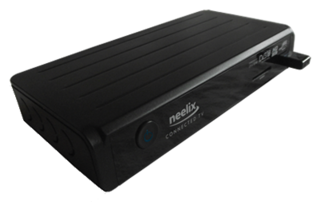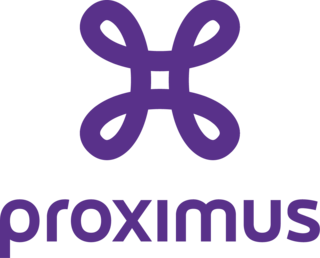
A set-top box (STB), also known as a cable box or receiver and historically television decoder, is an information appliance device that generally contains a TV-tuner input and displays output to a television set and an external source of signal, turning the source signal into content in a form that can then be displayed on the television screen or other display device. They are used in cable television, satellite television, and over-the-air television systems as well as other uses.

Video on demand (VOD) is a media distribution system that allows users to access to videos, television shows and films without a traditional video playback device and a typical static broadcasting schedule. In the 20th century, broadcasting in the form of over-the-air programming was the most common form of media distribution. As Internet and IPTV technologies continued to develop in the 1990s, consumers began to gravitate towards non-traditional modes of content consumption, which culminated in the arrival of VOD on televisions and personal computers.

The media of Canada is highly autonomous, uncensored, diverse, and very regionalized. Canada has a well-developed media sector, but its cultural output—particularly in English films, television shows, and magazines—is often overshadowed by imports from the United States. As a result, the preservation of a distinctly Canadian culture is supported by federal government programs, laws, and institutions such as the Canadian Broadcasting Corporation (CBC), the National Film Board of Canada (NFB), and the Canadian Radio-television and Telecommunications Commission (CRTC).
Wireless local loop (WLL), is the use of a wireless communications link as the "last mile / first mile" connection for delivering plain old telephone service (POTS) or Internet access to telecommunications customers. Various types of WLL systems and technologies exist.

The Proximus Group is a provider of digital services and communication in Belgium and the international markets. In Belgium, its main products and services are offered under the Proximus, Scarlet, and Mobile Vikings brands. The Group is also active in Luxembourg as Proximus Luxembourg SA, under the brand names Tango and Telindus Luxembourg, and in the Netherlands through Telindus Netherlands. The Group's international carrier activities are carried out by BICS and Telesign one of the world's leading voice carriers and the largest provider of mobile data services worldwide. Proximus Accelerators, its ecosystem of IT partners, support companies in their digital transformation.
A digital video recorder (DVR) is an electronic device that records video in a digital format to a disk drive, USB flash drive, SD memory card, SSD or other local or networked mass storage device. The term includes set-top boxes with direct to disk recording, portable media players and TV gateways with recording capability, and digital camcorders. Personal computers are often connected to video capture devices and used as DVRs; in such cases the application software used to record video is an integral part of the DVR. Many DVRs are classified as consumer electronic devices; such devices may alternatively be referred to as personal video recorders (PVRs), particularly in Canada. Similar small devices with built-in displays and SSD support may be used for professional film or video production, as these recorders often do not have the limitations that built-in recorders in cameras have, offering wider codec support, the removal of recording time limitations and higher bitrates.

A cable television headend is a master facility for receiving television signals for processing and distribution over a cable television system. A headend facility may be staffed or unstaffed and is typically surrounded by some type of security fencing. The building is typically sturdy and purpose-built to provide security, cooling, and easy access for the electronic equipment used to receive and re-transmit video over the local cable infrastructure. One can also find head ends in power-line communication (PLC) substations and Internet communications networks.
Public-access television is traditionally a form of non-commercial mass media where the general public can create content television programming which is narrowcast through cable television specialty channels. Public-access television was created in the United States between 1969 and 1971 by the Federal Communications Commission (FCC), under Chairman Dean Burch, based on pioneering work and advocacy of George Stoney, Red Burns, and Sidney Dean.
In cable television, governments apply a must-carry regulation stating that locally licensed television stations must be carried on a cable provider's system.

Internet Protocol television (IPTV) is the delivery of television content over Internet Protocol (IP) networks. This is in contrast to delivery through traditional terrestrial, satellite, and cable television formats. Unlike downloaded media, IPTV offers the ability to stream the source media continuously. As a result, a client media player can begin playing the content almost immediately. This is known as streaming media.

CableCARD is a special-use PC Card device that allows consumers in the United States to view and record digital cable television channels on digital video recorders, personal computers and television sets on equipment such as a set-top box not provided by a cable television company. The card is usually provided by the local cable operator, typically for a nominal monthly fee.

Caracol Televisión is a Colombian free-to-air television network owned by Caracol Medios, a unit of Grupo Valorem. It is one of the leading private TV networks in Colombia, alongside Canal RCN and Canal 1. The network distributes and produces 5,000+ programs and has aired in more than 80 countries.
A television station is a set of equipment managed by a business, organisation or other entity, such as an amateur television (ATV) operator, that transmits video content and audio content via radio waves directly from a transmitter on the earth's surface to any number of tuned receivers simultaneously.
Cable television first became available in the United States in 1948. By 1989, 53 million U.S. households received cable television subscriptions, with 60 percent of all U.S. households doing so in 1992. Most cable viewers in the U.S. reside in the suburbs and tend to be middle class; cable television is less common in low income, urban, and rural areas.

UPC was the largest cable operator in Switzerland with around 1.1 million residential and business customers and was formed in 1994 through the merger of several cable operators. UPC has been a subsidiary of Liberty Global since 2005.
The Vision Interfaith Satellite Network (VISN) was an American religious cable and satellite television network that was owned by the interfaith group National Interfaith Cable Coalition, in cooperation with cable operators. The channel became known as the "PBS of religion" for the inclusive nature of its programming, which was designed to "place its accent on dialogue rather than apologies."
GS Group is the largest Russian developer and producer of set-top boxes for television. Since 1991 company has been conducting systematic research and development work and producing radio electronic equipment. Company products and technology concepts are used in satellite broadcasting projects NTV-PLUS, Tricolor TV, Platform HD etc. Total number of TV subscribers using set-top boxes produced by the Corporation in Russian Federation exceeds 7 million. In 2007 General Satellite became the main investor of the integral innovation project: "Technopolis GS: scientific and technological development territory", which is implemented in Gusev town, Kaliningrad Region. It was a major contractor for NTV-PLUS company in 90s in Russia.
The distribution of cable television around the world:

RT en Español is a Spanish-language pay television channel of the RT network. RT Spanish was launched in 2009 and is also known as Actualidad RT.
Inter is a Venezuelan television broadcaster and telecommunications provider headquartered in Barquisimeto, Lara, Venezuela. Inter was founded in 1996 as InterCable. Its fiscal name is Corporacion Telemic C.A, and its main shareholder is the investment fund HM Capital Partners.








